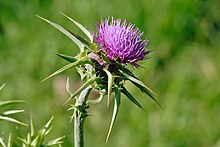Milk thistle
| Milk thistle | |
|---|---|
 |
|
| Scientific classification | |
| Kingdom: | Plantae |
| (unranked): | Angiosperms |
| (unranked): | Eudicots |
| (unranked): | Asterids |
| Order: | Asterales |
| Family: | Asteraceae |
| Tribe: | Cynareae |
| Genus: | Silybum |
| Species: | S. marianum |
| Binomial name | |
|
Silybum marianum (L.) Gaertn. |
|
| Synonyms | |
|
Carduus marianus L. |
|
Carduus marianus L.
Silybum marianum has other common names include cardus marianus, milk thistle,blessed milkthistle,Marian thistle, Mary thistle, Saint Mary's thistle, Mediterranean milk thistle, variegated thistle and Scotch thistle. This species is an annual or biennial plant of the Asteraceae family. This fairly typical thistle has red to purple flowers and shiny pale green leaves with white veins. Originally a native of Southern Europe through to Asia, it is now found throughout the world.
Milk thistles can grow to be 30 to 200 cm (12 to 79 in) tall, and have an overall conical shape. The approximate maximum base diameter is 160 cm (63 in). The stem is grooved and more or less cottony. The largest specimens have hollow stems.
The leaves are oblong to lanceolate. They are either lobate or pinnate, with spiny edges. They are hairless, shiny green, with milk-white veins.
The flower heads are 4 to 12 cm long and wide, of red-purple colour. They flower from June to August in the North or December to February in the Southern Hemisphere (summer through autumn).
The bracts are hairless, with triangular, spine-edged appendages, tipped with a stout yellow spine.
The achenes are black, with a simple long white pappus, surrounded by a yellow basal ring.
Possibly native near the coast of southeast England, it has been widely introduced outside its natural range, for example into North America, Iran, Australia and New Zealand where it is considered an invasive weed. Cultivated fields for the production of raw material for the pharmaceutical industry exist on a larger scale in Austria (Waldviertel region), Germany, Hungary, Poland, China and Argentina. In Europe it is sown yearly in March–April. The harvest in two steps (cutting and threshing) takes place in August, about 2–3 weeks after the flowering.
...
Wikipedia
